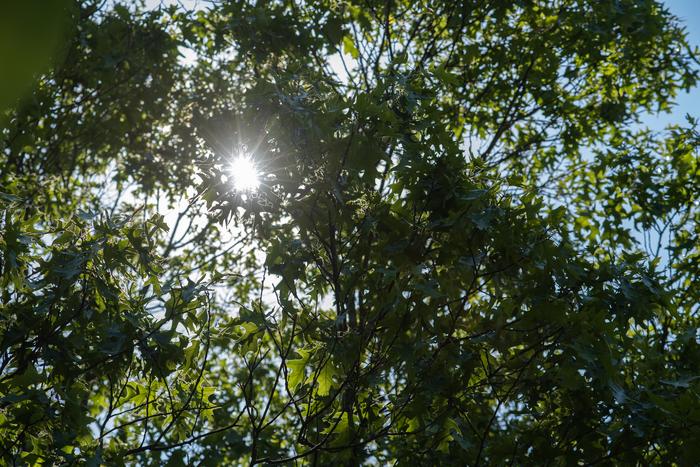Researchers at West Virginia University are working to ensure small landowners and local communities, instead of large corporations, profit from the ability of Central Appalachian forests to remove greenhouse gas carbon dioxide from the atmosphere.

Credit: (WVU Photo/Alyssa Reeves)
Researchers at West Virginia University are working to ensure small landowners and local communities, instead of large corporations, profit from the ability of Central Appalachian forests to remove greenhouse gas carbon dioxide from the atmosphere.
So-called “forest-based climate solution programs” manage forest ecosystems in a way that enhances carbon storage by planting trees, for example, or by restricting logging. To ensure these programs benefit both forests and local communities, a WVU team will spend the next four years investigating how different management practices affect Appalachian forest life — from the trees and other flora that grow there to the loggers, farmers, trail riders and ginseng gatherers who are also part of those ecosystems.
The project is supported by $1.7 million from the National Science Foundation.
“To curb climate change, we have to reduce fossil fuel emissions. But we can also take advantage of our forests’ ability to remove the carbon dioxide in our atmosphere and store it long term in wood and soils,” said Steven Kannenberg, assistant professor of biology at the WVU Eberly College of Arts and Sciences. “In particular, the forests of the eastern U.S. are an incredibly large carbon sink. The amount of carbon dioxide they capture is equivalent to 40-60% of the region’s fossil fuel emissions.”
There’s money to be made from that carbon capture. In 2023, the Biden Administration poured $150 million into forest-based climate solution programs targeting small-acreage landowners. The financial markets trade billions of dollars in carbon offset credits every year.
However, although about 70% of eastern U.S. forests are under small individual or family ownership, little revenue has made its way to local communities. Instead, Kannenberg said forest-based climate projects “are overwhelmingly conducted on corporate landholdings owned by entities outside the region.”
He said he believes identifying incentives for local landowners to allow carbon management programs on their properties is essential to combatting climate change. Landowners who agree to host these programs contract with companies to receive regular payments, based on acreage and the estimated amount of carbon stored, over a set number of years.
The contracts have been a hard sell among small landholders in Appalachia, partly because revenues are only significant for large parcels. Owners typically must allow forestry management practices to happen on the land, and the long contracts restrict owners’ abilities to use the land for some commercial purposes or as collateral on loans.
Kannenberg also noted that while forestry management practices for improving soil health or biodiversity yield several potentially profitable “co-benefits” beyond just carbon capture, neither landowners nor forestry managers have the data they need to forecast those revenues.
The team will ask about problems like those in the surveys they’ll send to thousands of small landowners across the region, and in interviews with loggers, sawmill operators, tourism small business operators and other participants in the forest economy of a former Clearfork Valley mining community on the Tennessee-Kentucky border.
The researchers will also fill serious knowledge gaps about how different management practices affect forests’ carbon sequestration capabilities, looking to sites where detailed logging records have been kept for a century: Fernow Experimental Forest, WVU Research Forest, Summit Bechtel Reserve and Monongahela National Forest. Each forest contains mature, undisturbed areas as well as areas that have been logged using a variety of common practices.
By measuring factors like tree height, leaf area, the mass of root systems, the nutrients in the soil and annual growth using tree rings, the team will quantify the impacts of human intervention on the ecosystem over time.
Already, preliminary data has revealed how forestry management in those zones changed the species distribution and weakened resilience to climate change. At Fernow, red oaks became less prevalent after timber was harvested, replaced by trees without the oak’s ability to store large amounts of carbon and resist drought conditions.
“Eastern U.S. forests are critical to meeting greenhouse gas emission targets,” Kannenberg said. “Eastern forests are more resilient to climate change than the arid forests of the western U.S. because stressors such as rising temperatures, increasing drought, and enhanced pest and pathogen presence are projected to be less severe.
“That’s why projects exploring forest-based climate solutions are exploding in Central Appalachia. This region is going to be the model for how forested communities worldwide will transition out of economies based on fossil fuel extraction.”
Decarbonization seed funding secured by the WVU Research Office permitted the acquisition of some initial data.
The WVU research team also includes Kathryn Gazal, associate professor of forest resources management in the WVU Davis College of Agriculture and Natural Resources, as well as Brenden McNeil, professor of geography, and Edward Brzostek, associate professor and associate chair for graduate studies, both from the Eberly College.



